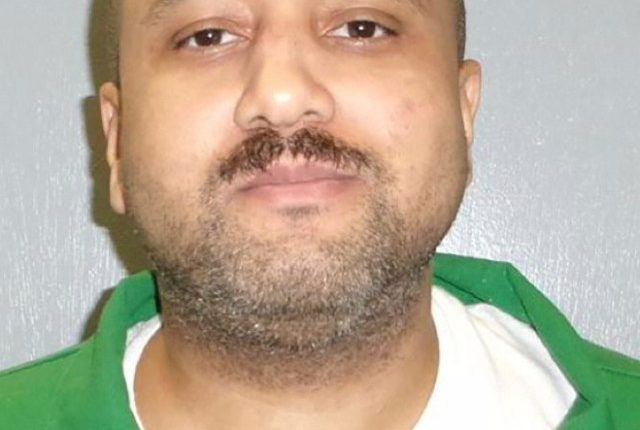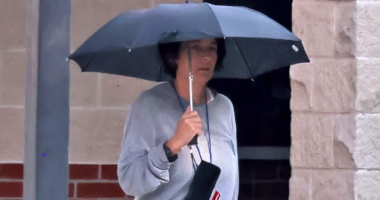Share this @internewscast.com
Experts have criticized a South Carolina firing squad for allegedly mishandling the execution of a convicted police officer’s killer, causing him “excruciating” pain as he bled out.
An autopsy commissioned by the state disclosed that none of the bullets directly struck Mikal Mahdi’s heart, which is the intended target in such executions.
Mikal Mahdi, 42, was shot dead by the firing squad on April 11, marking South Carolina’s second execution by firing squad in just over a month.
According to NPR, the autopsy of Mahdi’s chest revealed only two bullet wounds rather than the expected three from the prison staff members who volunteered to be part of the firing squad.
It has been revealed that the bullets injured his liver and other internal organs but missed his heart, which continued to beat, thereby leaving him alive for roughly a minute, experts said.
The autopsy was filed on Thursday by Mahdi’s lawyers with a letter to the South Carolina Supreme Court titled “Notice of botched execution.”
“Mr. Mahdi did experience excruciating conscious pain and suffering for about 30 to 60 seconds after he was shot,” pathologist Dr. Jonathan Arden wrote in his analysis of the autopsy.
Arden, hired by Mahdi’s legal team to review the autopsy, added that Mahdi was “alive and reacting longer than was intended or expected.”
Dr. Carl Wigren, a forensic pathologist who reviewed the autopsy documents for NPR, said, “He’s not going to die instantaneously from this.”
He added, “I think that it took him some time to bleed out.”
Mahdi was sentenced to death for the 2004 murder of off-duty public safety officer Captain James Myers, who was shot nine times and set on fire in a shed where he had married his wife just 15 months earlier.
He was also convicted of murdering two other people, as well as of carjacking and firearm robbery.
The killer chose to be executed by firing squad over lethal injection or the electric chair, as he feared being “burned and mutilated” or “suffering a lingering death”, his attorney said.
Strapped to a metal chair beneath a hood and with a red bullseye target placed over his heart, Mahdi gave no final words and refused to look at the nine witnesses behind the bulletproof glass.
He cried out and flexed his arms as three prison staff fired rounds into his chest, then groaned twice more before taking a final breath 80 seconds later.
A doctor pronounced him dead four minutes after the shots were fired.
Though South Carolina’s constitution bans cruel or unusual punishment, the state Supreme Court ruled last year that firing squads aren’t cruel – claiming death occurs within 15 seconds.
“The evidence before us convinces us – though an inmate executed via the firing squad is likely to feel pain, perhaps excruciating pain – that the pain will last only ten to fifteen seconds,” the justices wrote.
“Unless there is a massive botch of the execution in which each member of the firing squad simply misses the inmate’s heart.”
A doctor noted in the comments section on the state autopsy that “it is believed that” two bullets went through one wound.
But pathologists who reviewed were skeptical that two bullets went through precisely the same small hole.
“I think the odds of that are pretty minuscule,” Wigren said.
Jeffrey Collins, a reporter for the Associated Press, wrote that he heard Mahdi groan twice about 45 seconds after shots.
He claimed Mahdi continued to breathe for another 80 seconds before he appeared to take a final gasp.
Pathologist Arden concluded in his report, “Both the forensic medical evidence and the reported eyewitness observations of the execution corroborate that Mr. Mahdi was alive and reacting longer than was intended or expected.”
Lethal injection controversy in South Carolina

By Patrick Harrington, foreign news reporter
THE three most recent executions in South Carolina were by lethal injection, and the cases have sparked controversy.
It took around 20 minutes before each of the three men were officially declared dead.
Complicating the situation is a law passed in 2023 which restricts much of the information about executions being made public.
It requires the identities of execution team members remain secret and forbids the publication of information about how the drugs are bought by the state.
This follows a growing number of pharmaceutical companies refusing to sell their drugs to be used in executions.
The American Civil Liberties Union (ACLU) filed a lawsuit challenging the state law in January.
It wrote: “This ban not only further departs from the state’s history of making execution-related information publicly available but criminalizes the disclosure of this information by anyone for any reason.
“It thus silences the scientists, doctors, journalists, former correctional officials, lawyers, and citizens who have scrutinized the safety, efficacy, morality, and legality of South Carolina’s use of lethal injection.”
The state has released only one of two available autopsies from the recent executions, and Brad Sigmon’s lawyers say it shows an unusual amount of fluid in the man’s lungs.
Mahdi’s execution was the fifth in the state in less than eight months, and the 12th in the US so far this year.
During his trial, Assistant Solicitor David Pascoe called him “the epitome of evil” and said, “His heart and mind are full of hate and malice.”
Myers’ wife, Amy Tripp Myers, gave a heartbreaking testimony.
“I found the love of my life, my soulmate, the partner that my life revolved around, lifeless, lying in a pool of blood and his body burned by someone who didn’t even know him,” she said.
In a letter written before his death, Mahdi admitted, “I’m guilty as hell… What I’ve done is irredeemable.”
Despite a final push by his legal team and childhood teachers calling for clemency, Republican Governor Henry McMaster denied a last-minute appeal.
The US Supreme Court also rejected his final petition.
Mahdi’s death followed the execution of 67-year-old Brad Sigmon in March, the first firing squad execution in South Carolina after a 13-year pause.























